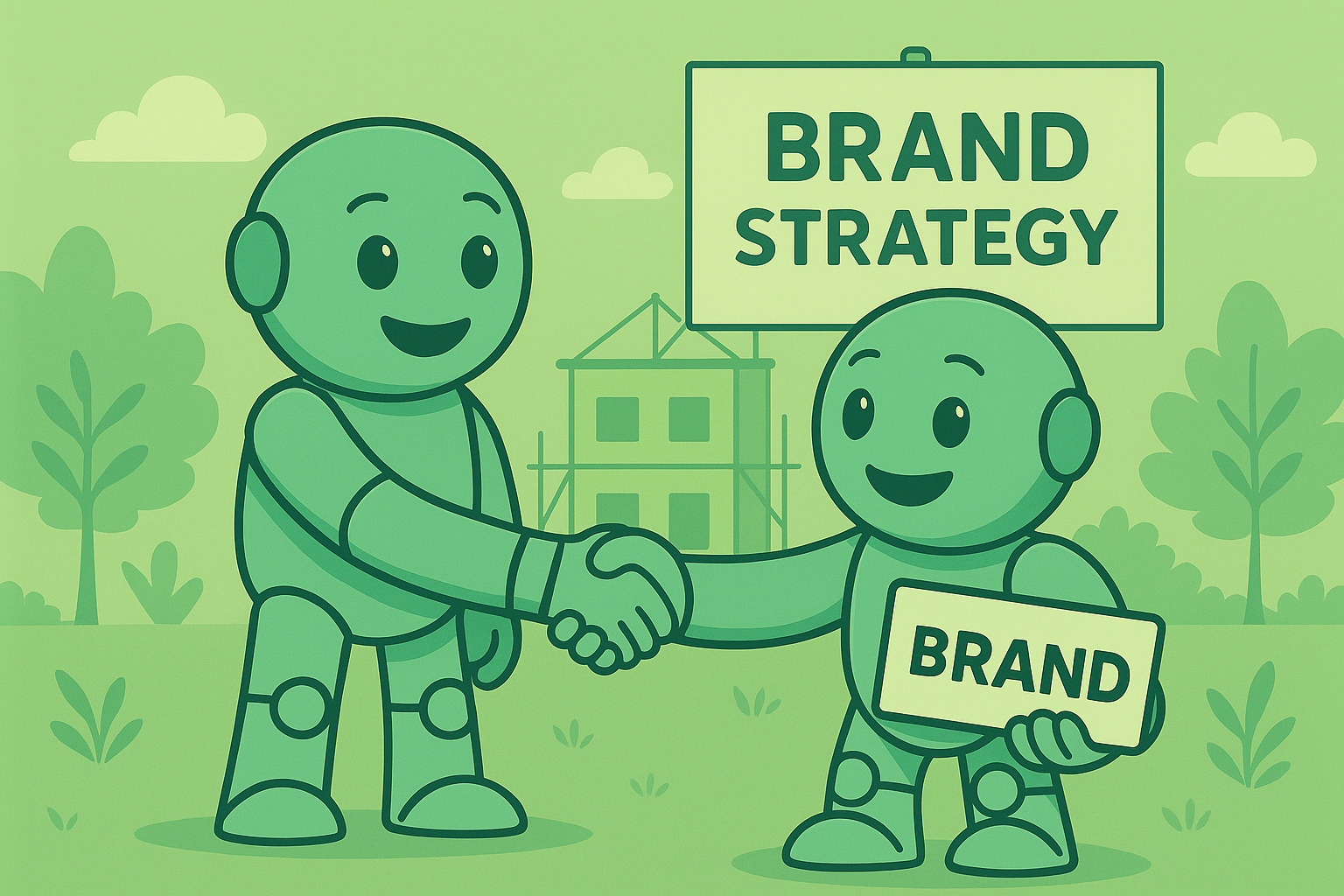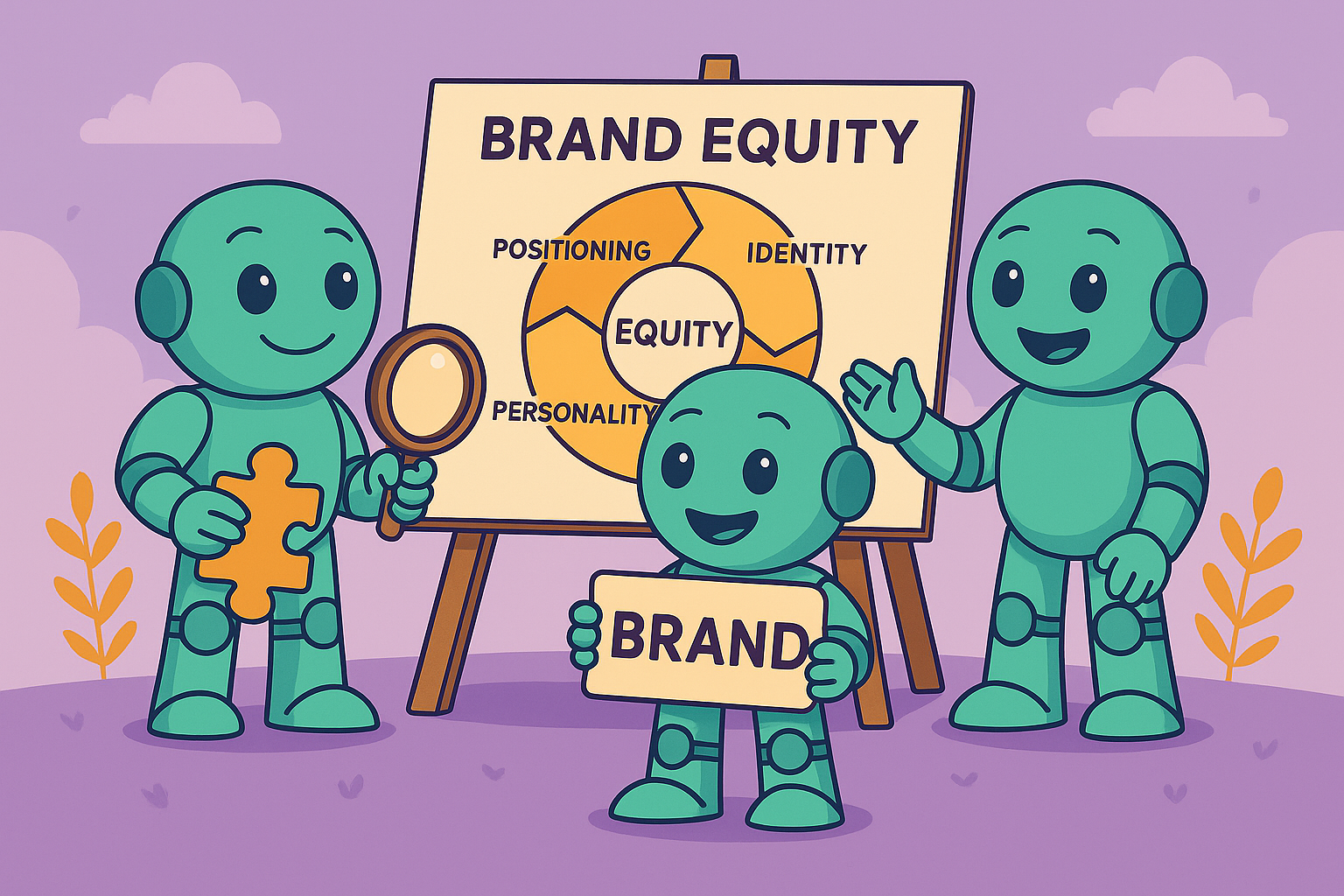Effective Brand Management Strategy for Business Growth
Your brand is much more than just a logo or a catchy slogan. Think of it as your company's reputation—a living, breathing entity shaped by every single interaction someone has with your business. A brand management strategy is the long-term plan you create to consciously nurture that reputation, ensuring every experience is consistent, positive, and memorable.
What Is Brand Management Strategy

At its heart, a brand management strategy is the deliberate process of influencing how people think and feel about your company. It's the master plan that ensures your actions align with your words, building awareness, trust, and ultimately, loyalty. This isn't just about marketing; it’s about shaping your entire reputation.
This strategic thinking extends far beyond a one-off campaign or a visual refresh. It touches everything—from the personality in your social media posts and the helpfulness of your customer service, to the user-friendliness of your website. The ultimate goal? To craft a cohesive and reliable experience that secures a strong, positive space in your customers' minds.
Why It Matters More Than Ever
In today's crowded market, competitors can copy a product or a service, but they can't replicate a powerful brand. A well-managed brand serves as a mental shortcut for customers, making their buying decisions easier and giving them confidence. It turns your name into a promise of quality, reliability, and shared values.
This is where perception and trust become your most valuable currency. The numbers don't lie: a staggering 81% of consumers say they need to trust a brand before they'll even consider buying from it. With 55% of first impressions being visual, consistent branding is your first and best chance to grab attention and establish credibility. You can dive deeper into these kinds of branding statistics and their impact to see just how critical this is.
A brand is no longer what we tell the consumer it is—it is what consumers tell each other it is. An effective brand management strategy gives you a powerful voice in that conversation, actively shaping the narrative rather than letting it happen to you.
The Core Pillars of a Strong Strategy
A truly effective strategy isn't built on a single idea, but on several foundational pillars working in harmony. Getting these components right is the first step toward building a brand that doesn't just attract customers, but creates loyal advocates for years to come.
The table below breaks down these fundamental components, giving you a clear overview of what goes into a world-class brand management strategy.
The Core Pillars of Brand Management
| Pillar | Description | Key Objective |
|---|---|---|
| Brand Positioning | Defining your unique place in the market and in the minds of your target audience. | To stand out from competitors and establish clear relevance for your customers. |
| Brand Identity | All the tangible elements that represent your brand, like your logo, colors, fonts, and tone of voice. | To build a consistent, memorable, and instantly recognizable presence. |
| Brand Experience | The complete picture of every interaction a customer has with your brand, from digital channels to in-person contact. | To deliver a seamless journey that is consistently positive and unforgettable. |
| Brand Equity | The influence and perceived value your brand holds in the marketplace, built up over time through consistency and trust. | To foster deep customer loyalty and justify a premium price point. |
Think of these pillars as the essential ingredients in your brand's recipe for success. Each one is distinct, yet they all work together to create something strong, cohesive, and valuable.
The Anatomy of a Winning Brand Strategy
Alright, let's move from the abstract idea of "brand strategy" to what it actually looks like in practice. A winning brand isn't built on a single brilliant idea; it’s more like a symphony, where every instrument plays its part in perfect harmony. These components are the actual blueprint for building a brand that people don't just recognize, but genuinely care about.
Think of it like building your dream house. You need a solid foundation (that's your positioning), a distinct architectural style (your identity), a welcoming vibe inside (your personality), and finally, a property that becomes more valuable over time (your equity). If you cut corners on any of these, the whole structure starts to feel a bit wobbly.
Defining Your Market Position
First things first: before you can manage your brand, you have to know where it stands. Brand positioning is the art and science of carving out a unique and valuable spot in your customer's mind. It answers the most critical question of all: "Why should someone choose us over the competition?" This isn't about trying to be everything to everyone. It's about being the absolute best choice for a specific group of people.
A sharp positioning statement becomes your North Star, guiding every single decision you make—from product development to marketing campaigns. It clearly states what you stand for, who you're here to serve, and what makes you different. For example, a car company might position itself as the safest choice for families. That one decision then dictates its engineering priorities, its safety feature promotions, and even the tone of its commercials.
Crafting a Tangible Brand Identity
If positioning is the strategy, brand identity is how you bring it to life. This covers all the tangible, sensory elements that make your brand unmistakable. When you get the identity right, every interaction a customer has with you feels consistent and reinforces what you’re all about.
And no, it’s not just about slapping a logo on everything. A complete identity includes:
- Your Visual System: The logo, color palette, typography, and photography style. Together, they create a cohesive visual language that’s instantly recognizable.
- Your Voice and Tone: This is how your brand "sounds" in writing. Are you a formal authority, or a friendly, approachable guide? That voice needs to be consistent, whether it's on your website, a social media post, or a customer service email.
- Your Brand Name and Slogan: These are the verbal anchors of your identity. They need to be memorable, meaningful, and perfectly capture the essence of your brand.
Putting these pieces together takes real creativity and strategic thinking. If you're building from the ground up, getting a handle on creating a brand identity is one of the most important first steps you can take.
Cultivating a Relatable Brand Personality
So, identity is what your brand looks and sounds like. Brand personality is how it behaves and makes people feel. It’s the set of human characteristics we instinctively give it. Is your brand a wise mentor? A playful sidekick? A sophisticated leader? It's this personality that allows customers to form a real, emotional connection with you.
A brand with a strong personality doesn't just sell products; it creates relationships. Consumers are drawn to brands that reflect their own values and aspirations, turning a simple transaction into an act of self-expression.
Developing this personality means intentionally weaving it into every customer touchpoint. An outdoor gear company with a rugged, adventurous personality won't use polished studio shots; it'll show real people climbing real mountains. Its customer service reps won't just be reading scripts; they'll be fellow enthusiasts who can offer credible, expert advice. That's personality in action.
Building and Measuring Brand Equity
This final piece of the puzzle, brand equity, is the ultimate payoff for all your hard work. In simple terms, it's the commercial value your brand name holds, separate from the actual product or service itself. High brand equity is why people will choose you without a second thought, stay loyal for years, and even pay a little more for what you offer.
This value is built slowly and steadily, by consistently delivering on your brand promise. It's the direct result of having a strong position, a clear identity, and a relatable personality. To manage it effectively, you need to measure it. That's where a regular brand audit comes in.
This infographic breaks down how a brand audit helps you get a grip on awareness, perception, and where you stand against competitors.

Analyzing these areas gives you a clear snapshot of your brand’s health and shows you whether your strategy is actually working. Each of these four components—positioning, identity, personality, and equity—are deeply connected. They feed into each other, creating a powerful cycle that drives real, sustainable growth.
How to Build Brand Equity and Drive Loyalty
The real end game of brand management isn't just getting noticed; it's about building lasting value. This value is what we call brand equity, and it’s the secret ingredient that turns a one-time buyer into a lifelong fan. It’s that potent mix of reputation and perception that lets you stand out and earn loyalty, even in the most crowded markets.
Building this kind of equity is a marathon, not a sprint. It demands a deliberate, sustained effort to create a cycle where your happiest customers become your best marketers. When you nail the delivery of consistent quality and meaningful experiences, you build a brand people don't just buy from, but actively root for.
Anchor Loyalty in Quality and Consistency
At the heart of any loyal following is an undeniable commitment to quality. Nothing sells better than a fantastic product or a service that’s excellent every single time. When customers know they can count on you, they don’t just come back—they tell their friends.
That organic word-of-mouth is gold. It builds a foundation of trust that no amount of advertising can buy. To earn it, every single interaction, from the product itself to a customer service chat, has to deliver on your brand's promise. This relentless consistency is what convinces a customer to stick around for the long haul.
Of course, paid media often gets the ball rolling. While organic growth is the goal, you first need to get on people's radar. Research shows that around 83% of consumers find new brands through online ads. But what makes them stay is the experience; 51% of consumers will champion a brand online simply because they love the product. It’s a perfect partnership between paid discovery and organic advocacy. You can dive deeper into these pivotal marketing trends to see how they fit together.
A great product sells itself once, but a great brand experience sells it for a lifetime. Loyalty isn't bought; it's earned through every single high-quality touchpoint.
Drive Growth with Purpose and Responsibility
Today’s customers are buying more than just a product; they’re buying into what a brand represents. A huge piece of modern brand management is showing a real, tangible commitment to social and environmental responsibility. This isn't just a "nice-to-have" anymore—it's a massive driver of customer preference and loyalty.
Brands that genuinely embrace sustainability and ethical practices forge much deeper connections. This can take many forms, including:
- Sustainable Sourcing: Using eco-friendly materials and being transparent about your supply chain.
- Ethical Operations: Committing to fair labor practices and responsible manufacturing processes.
- Community Engagement: Giving back to the community through donations, partnerships, or local initiatives.
When your brand’s values mirror your customers' values, you create a bond that goes far beyond the transaction. This purpose-driven approach gives people a powerful reason to choose you over a competitor, even if your prices are similar.
Create a Self-Sustaining Growth Cycle
At the end of the day, building powerful brand equity is about creating a virtuous cycle. It all starts with a smart investment in awareness, gets proven by a top-notch product, and is then supercharged by the advocacy of your loyal customers.
Think of it as a flywheel that powers your growth:
- Awareness: Strategic paid media and marketing introduce your brand to the right people.
- Experience: Those new customers are wowed by the quality and consistency you deliver.
- Loyalty: Happy customers come back for more, developing a genuine connection to your brand.
- Advocacy: These loyal fans become your champions, spreading the word and driving powerful, authentic growth.
This self-sustaining loop is the engine of a truly strong brand. By centering your brand management strategy on quality, consistency, and purpose, you don't just acquire customers—you build a community of advocates who will carry your brand forward.
Using Technology to Personalize Brand Experiences
Let’s be honest: in a world saturated with digital noise, generic messages just don’t cut it anymore. Technology isn't just about doing things faster; it's about building genuine, one-on-one connections with your audience, even at a massive scale. A modern brand management strategy doesn't use tech to replace the human touch—it uses it to make every interaction more meaningful and personal.
Imagine trying to have a real conversation with thousands of people at once. You'd need to remember every name, preference, and past chat. It’s a superhuman task. But that’s exactly what technology empowers a brand to do. By gathering and making sense of data, you can stop broadcasting one message to everyone and start having thousands of personalized conversations simultaneously.
Tapping into Data and AI for Deeper Insights
True personalization starts with understanding who your audience really is, right down to the nitty-gritty details. This is where data analytics and artificial intelligence (AI) become your most valuable assets. These aren't just buzzwords; they are tools that dig deeper than basic demographics to reveal patterns in customer behavior, preferences, and what truly motivates them.
Instead of guessing what your customers want, you can actually know. Technology gives you the answers to the critical questions that define your brand experience:
- What content actually lands? AI can analyze which articles, videos, or social posts get the best reactions from different customer groups.
- When's the perfect time to reach out? Automation tools can schedule communications to arrive precisely when individual users are most likely to be online and engaged.
- What should you recommend next? E-commerce platforms can use a customer's browsing history and past purchases to suggest products they'll genuinely love—just like a sharp, attentive shop assistant would.
This data-first approach lets you fine-tune every touchpoint. The result? Each customer feels seen, understood, and valued.
Automating Thoughtfulness at Scale
Once you have those rich insights, automation is how you bring your personalized strategy to life. It’s what allows you to deliver those tailored experiences consistently and without having a team manually crafting every single interaction. Think of it as setting up a system of smart, thoughtful rules that trigger the right message at the perfect moment.
A brand that uses technology to remember a customer's birthday, suggest a product they'll love, or offer help right when they seem stuck isn't just being smart—it's being thoughtful. Personalization is the modern-day version of great customer service.
It's no surprise that investment in this area is skyrocketing. In fact, about 56% of marketing leaders are increasing their personalization budgets. And the technology is advancing at a breakneck pace; by the end of 2024, nearly all enterprise software is expected to have generative AI features baked right in. This isn't a fleeting fad; it's a fundamental shift in brand management. You can discover more insights about these marketing trends and how they're reshaping business strategy.
Forging a Competitive Edge
Ultimately, using technology for personalization is how you build a powerful competitive advantage. While your competitors are shouting one generic message to the masses, you're whispering the perfect thing to each individual. This creates a stickier, more loyal customer relationship that is incredibly difficult for anyone else to break.
This approach transforms your brand from a faceless corporation into a helpful, trusted partner on your customer’s journey. By proving you understand their needs—not just their wallets—you build the kind of deep-seated trust and loyalty that sits at the very heart of a successful, enduring brand.
Inspiring Examples of Brand Management Mastery
Theory and frameworks are the blueprint, but seeing a masterful brand management strategy in action is what really makes the concepts click. To truly grasp how these principles lead to market dominance and die-hard customer loyalty, it helps to look at companies that have woven their brands into the fabric of our culture.
These businesses do more than just sell products. They sell an identity, a feeling, and a promise. Let’s break down the playbooks of a few iconic brands to see exactly how they cemented their place in our hearts and minds.
Apple: From Technology to Lifestyle
Apple is the quintessential example of a tech company that became a global lifestyle brand. Their success isn't just about making great gadgets; it’s about an obsessive focus on creating a cohesive and aspirational world around their products.
The foundation of Apple's strategy is a deep, unwavering commitment to simplicity and clean design. This isn't just an aesthetic choice—it's a promise of an intuitive and frictionless user experience. From the minimalist packaging to the uncluttered software interfaces, every single touchpoint reinforces this core value.
This consistency has built staggering brand equity. People aren't just buying a phone; they're buying into an ecosystem they trust to be innovative, well-made, and easy to use. This creates a powerful "halo effect," where loyalty to one Apple product naturally extends to others.
Apple's brand management strategy is a masterclass in control and consistency. They have meticulously crafted an image of innovation and premium quality, allowing them to command higher prices and cultivate a fiercely loyal customer base that sees the brand as an extension of their own identity.
Nike: From Shoes to Motivation
Nike famously sells more than just athletic wear; it sells motivation. The brand's mission, "to bring inspiration and innovation to every athlete in the world," is deliberately broad and inclusive. It makes everyone, from the professional to the weekend warrior, feel like an athlete.
Their brand management is built on a bedrock of powerful, emotional storytelling. Instead of rattling off product features, Nike’s marketing tells stories of overcoming adversity, achieving greatness, and pushing personal limits. The legendary "Just Do It" slogan is a call to action that resonates on a deeply human level, far beyond the world of sports.
Nike has also masterfully managed its brand by:
- Forging Powerful Partnerships: Collaborations with top-tier athletes like Michael Jordan and Serena Williams create a direct link between the brand, peak performance, and success.
- Building a Community: Apps like the Nike Run Club and Nike Training Club create an entire ecosystem that keeps users engaged with the brand long after the initial purchase.
- Taking a Stand: Nike hasn't shied away from aligning with social causes and sometimes controversial figures. It's a bold strategy that has strengthened its connection with its target audience by showing them what the brand truly values.
Lego: From Plastic Bricks to Infinite Creativity
Lego's brand management is a brilliant case study in adapting to change while staying true to your core. After facing near bankruptcy in the early 2000s, Lego dug deep and refocused on its essential promise: providing a system for creative play.
The company's incredible turnaround was driven by a disciplined strategy that put the humble brick back at the center of everything. They understood their brand wasn't just a toy, but a medium for imagination. This powerful insight led to a series of strategic moves that rebuilt and expanded their universe.
Here’s how they did it:
- Strategic Licensing: Partnering with massive franchises like Star Wars and Harry Potter introduced the Lego brand to new generations and passionate fanbases, perfectly blending established worlds with Lego's creative system.
- Expanding into Entertainment: The Lego movies weren't just feature-length commercials. They were critically acclaimed films that celebrated the brand's core values of creativity, fun, and working together.
- Engaging the Fan Community: Lego actively listens to and incorporates ideas from its adult fan community (AFOLs), effectively turning its most passionate customers into co-creators.
Each of these companies proves that a successful brand management strategy is a long-term commitment. It requires a deep understanding of your brand's core promise, the discipline to deliver on it consistently, and the creative spark to keep it relevant and inspiring for your audience.
Measuring the Success of Your Brand Strategy
A strong brand strategy isn't just about creative campaigns and clever taglines; it's a tangible business asset. But how do you actually prove its worth? To get buy-in for your marketing budget and fine-tune your efforts, you need to move beyond gut feelings and into the world of hard data.
Think of it like a personal fitness journey. You wouldn't just hope you're getting healthier; you’d track metrics like your weight, mile time, and strength to see real, measurable progress. The same goes for your brand. We need to look at specific key performance indicators (KPIs) that tell us what’s clicking and what’s falling flat. This is how we transform brand management from a subjective art into a data-backed science.
Gauging Brand Awareness and Reach
First things first: do people even know you exist? The initial step is to measure your brand’s visibility in the marketplace. We want to know if people are aware of you and if they're actively looking for you. Two core metrics paint a clear picture here.
-
Share of Voice (SOV): This is all about how much of the conversation your brand owns compared to your competitors. SOV tracks mentions across social media, news outlets, and blogs, giving you a percentage of your market’s attention.
-
Direct Traffic: This one is simple but powerful. It counts how many people visit your website by typing your URL directly into their browser. When direct traffic climbs, it’s a great sign that your brand name is becoming memorable and top-of-mind.
These numbers give you a solid baseline for your brand's visibility. Strong performance in these areas tells you that your top-of-funnel activities are successfully capturing attention.
Understanding Brand Perception and Sentiment
Okay, so people have heard of you. But what do they think and feel about your brand? This is where we dig into perception and the emotional connection you’re building.
Positive brand equity is built when consumers’ thoughts, feelings, and attitudes about your brand positively influence their willingness to pay. Measuring this perception is essential to understanding the real value you've created.
You can use sentiment analysis tools to scan online chatter and categorize mentions of your brand as positive, negative, or neutral. For a more direct and nuanced understanding, nothing beats customer surveys and focus groups. These qualitative methods let you ask specific questions about your brand’s reputation, perceived quality, and the values people associate with you.
Evaluating Customer Loyalty and Equity
Ultimately, the holy grail of brand management is loyalty. Loyal customers don't just buy from you again and again; they become your most passionate advocates. Measuring this deep connection is non-negotiable for long-term growth.
The Net Promoter Score (NPS) is a go-to metric for this. It’s based on a single, powerful question: "On a scale of 0-10, how likely are you to recommend our brand to a friend or colleague?" The answer gives you an immediate read on customer satisfaction and loyalty. Another crucial number is your customer retention rate, which tells you what percentage of your customers stick around over a given period.
To truly understand your brand's performance, you need a way to track these different facets over time. The table below outlines some of the most critical KPIs you should be watching.
Key Metrics for Measuring Brand Strategy Success
This table breaks down the essential KPIs for monitoring the health, performance, and ROI of your brand management initiatives.
| Metric Category | Key Performance Indicator (KPI) | What It Measures |
|---|---|---|
| Awareness & Reach | Share of Voice (SOV) | Your brand's visibility in the market compared to competitors. |
| Awareness & Reach | Direct Website Traffic | The number of visitors typing your URL directly, indicating brand recall. |
| Perception & Sentiment | Brand Sentiment Analysis | The ratio of positive, negative, and neutral mentions online. |
| Perception & Sentiment | Customer Surveys | Direct feedback on brand reputation, values, and perceived quality. |
| Loyalty & Equity | Net Promoter Score (NPS) | Customer willingness to recommend your brand, a proxy for loyalty. |
| Loyalty & Equity | Customer Retention Rate | The percentage of customers who continue to buy from you over time. |
| Business Impact | Customer Lifetime Value (CLV) | The total revenue a single customer is predicted to generate. |
| Business Impact | Brand-Related Search Queries | The volume of people searching for your brand name or branded products. |
By consistently tracking these metrics, you create a comprehensive system that goes beyond simple reporting. It provides actionable insights that help you build a stronger case for your strategy. For a more detailed look, our guide explains how to measure brand equity in practical steps. When you're armed with this kind of data, you can make smarter decisions, prove your strategy's ROI, and continuously fortify your brand’s position in the market.
Common Questions About Brand Management
It's natural to have questions when you're digging into brand management strategy. Getting clear answers is the first step toward building a plan that actually works. Let's walk through some of the most common questions I hear to clear up any confusion and get you on the right track.
Answering these helps get your whole team on the same page, so everyone understands the difference between the day-to-day work of branding and the bigger, long-term vision of managing the brand itself.
What Is the Difference Between Branding and Brand Management?
This is a big one, and it's easy to mix them up. The simplest way to think about it is this: branding is the creative act of building your brand’s core identity. It's the tangible stuff—your logo, your color scheme, your name, and the core messages you want to send. It’s the toolbox.
Brand management, on the other hand, is the strategic, ongoing process of using that toolbox. It’s about actively guiding how your audience perceives your brand over time. You’re not just building the assets; you’re steering the ship, protecting your reputation, and strengthening customer loyalty every single day.
How Often Should I Review My Brand Strategy?
Your brand management strategy isn't something you can just set and forget. For a major, deep-dive review, plan on doing it annually. This gives you a bird's-eye view, letting you make significant adjustments based on how the market has changed or where your business is headed.
That said, you need to be checking in much more frequently. Keep a close eye on key brand health metrics—things like social media sentiment, share of voice, and your Net Promoter Score (NPS)—on a monthly or quarterly basis. These regular check-ins are your early warning system, helping you catch and fix small issues before they snowball.
Always be ready to trigger an immediate strategy review after a major event. Think new product launches, a surprise competitor, a PR crisis, or a big shift in what your customers want. Being able to react intelligently is just as important as being proactive.
Can a Small Business Implement an Effective Strategy?
Absolutely. In fact, you could argue that a focused brand management strategy is even more crucial for a small business. When you're trying to stand out, you don't win with a massive budget; you win with consistency and authenticity.
For a smaller company, an effective strategy zeroes in on what you can control:
- Exceptional Customer Service: Making sure every single customer interaction is a perfect reflection of your brand's values.
- A Consistent Voice: Keeping your tone the same everywhere, from your website to your social media posts.
- Crystal-Clear Differentiation: Relentlessly communicating what makes you the better choice in a crowded field.
It’s not about outspending the big guys. It’s about being smarter and more consistent in everything you do.
What Is the First Step in Creating a Strategy?
The first, non-negotiable step is to gain a deep, honest understanding of your brand's purpose, your core values, and the audience you serve. You can't manage how you're perceived until you know exactly who you are and who you're for. This is your foundation.
This means rolling up your sleeves and doing the work: market research, competitor analysis, and internal workshops to nail down a solid brand positioning statement. This bedrock guides every decision that follows, from messaging to marketing. Getting this right is also critical when you're deciding on a name. For more on that, you can learn how to come up with a business name that truly fits your strategy.
Ready to find the perfect name that captures your brand's essence? The tools at NameRobot make it easy to generate, check, and perfect a name that will serve as the foundation of your brand management strategy. Start your naming journey with NameRobot today!















